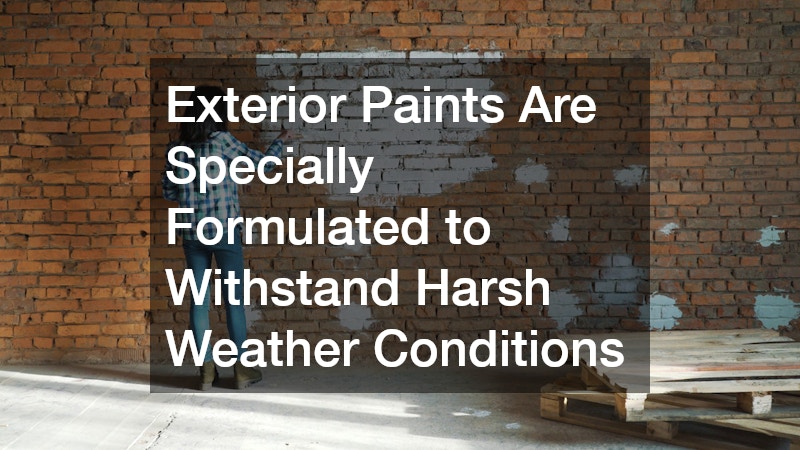
Homeowners and builders alike are often faced with the daunting choice of selecting the right type of exterior paint. Exterior paint serves as a critical shield, protecting the building from the elements while providing an appealing visual finish.
In this section, we delve into what defines exterior paint and why it is an essential consideration for any construction project.
Exterior paints are specially formulated to withstand the harsh conditions of the outdoors. They incorporate weather-resistant ingredients, such as UV blockers and mildew-resistant chemicals, which distinguish them from standard interior paints. Understanding these properties is crucial because the right exterior paint can significantly elongate the lifespan of a building’s façade.
In contrast to interior paints, exterior paints must contend with temperature fluctuations, moisture, and sunlight. These conditions require paints that can resist fading, cracking, and peeling. Thus, choosing the correct type of exterior paint not only ensures aesthetic appeal but also contributes to the structural health of the building.
Types of Exterior Paints
Numerous types of exterior paints are available on the market today, each designed for specific needs and surfaces. The most common are acrylic, latex, and oil-based paints. Understanding the distinct properties, advantages, and applications of these types is the first step in making an informed decision.
Acrylic paint is renowned for its durability and flexibility. It is resistant to harsh weather conditions and retains color better over time. This type of paint is ideal for its ability to adhere well to surfaces, reducing the likelihood of cracking or blistering even in extreme climates.
Latex paint, which is water-based, is often chosen for its easy application and quick drying qualities. It’s especially suitable for wood surfaces and is eco-friendly because it has low VOC (volatile organic compound) levels. On the other hand, oil-based paints offer a smoother finish and are durable against wear and tear, making them suitable for high-traffic areas.
Advantages and Considerations
Each type of exterior paint comes with its own set of advantages and considerations. Acrylic paint, for instance, is celebrated for its versatility and longevity. It’s an excellent option if you’re looking to minimize maintenance and repaint frequency, all while ensuring your home’s exterior looks fresh and vivid.
However, considerations must be weighed. Acrylic paints tend to be more expensive than their latex counterparts. Additionally, while acrylic paints are versatile, they may not always provide the best adhesion on certain surfaces like chalky or untreated wood unless appropriately primed.
Latex paints offer ease of use and cleanup, making them a popular choice for DIY enthusiasts. Their low VOC content makes them a safer choice for both the environment and human health. However, they can be less effective in very cold climates, where their performance may dip compared to oil-based paints.
Cost vs. Quality
One of the primary concerns when selecting exterior paint is the cost versus quality conundrum. Higher-priced paints often come with superior ingredients that promise better performance and longevity. However, buyers must discern whether these enhanced qualities justifiably outweigh the initial savings from cheaper options.
Acrylic paints, while pricier, offer a long-term return on investment due to their durability and resistance to environmental factors. They may constitute an upfront expense but could reduce future maintenance costs considerably. Latex paints often prove to be a cost-effective option, especially when frequent repainting is factored into areas with extreme weather conditions.
Oil-based paints offer a balance of cost and quality, providing a robust finish that can withstand wear in high-traffic areas. However, environmental considerations and longer drying times may offset their appeal for some buyers. Ultimately, understanding the intended use and environment will guide the cost versus quality decision.
Selecting the right exterior paint involves balancing several factors, including environmental suitability, budget, and the specific needs of the project. Each type of exterior paint brings its unique benefits and challenges to the table. By weighing the attributes of acrylic, latex, and oil-based paints, homeowners can make informed decisions in selecting a suitable exterior paint for their needs.
While the variety of products can be overwhelming, a thoughtful consideration of each type’s inherent properties can lead to a satisfying paint choice. Remember that cost should not be the only determinant. Consider the long-term benefits and durability that come with higher-quality paints, which may prove to be more economical in reducing the need for frequent application.
In conclusion, understanding the types of exterior paint is essential for maintaining an appealing and resilient building exterior. Choose wisely to ensure that aesthetics, performance, and cost all align with your desired outcomes. With the right choice, your investment in quality exterior paint will pay dividends in beauty and durability.

